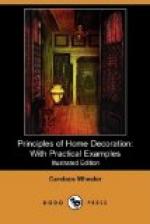We understand many of the properties of colour, and have unconsciously learned some of its laws;—but what may be called the science of colour has never been formulated. So far as we understand it, its principles correspond curiously to those of melodious sound. It is as impossible to produce the best effect from one tone or colour, as to make a melody upon one note of the harmonic scale; it is skilful variation of tone, the gradation or even judicious opposition of tint which gives exquisite satisfaction to the eye. In music, sequence produces this effect upon the ear, and in colour, juxtaposition and gradation upon the eye. Notes follow notes in melody as shade follows shade in colour. We find no need of even different names for the qualities peculiar to the two; scale—notes—tones—harmonies—the words express effects common to colour as well as to music, but colour has this advantage, that its harmonies can be fixed, they do not die with the passing moment; once expressed they remain as a constant and ever-present delight.
Notes of the sound-octave have been gathered by the musicians from widely different substances, and carefully linked in order and sequence to make a harmonious scale which may be learned; but the painter, conscious of colour-harmonies, has as yet no written law by which he can produce them.
The “born colourist” is one who without special training, or perhaps in spite of it, can unerringly combine or oppose tints into compositions which charm the eye and satisfy the sense. Even among painters it is by no means a common gift. It is almost more rare to find a picture distinguished for its harmony and beauty of colour, than to see a room in which nothing jars and everything works together for beauty. It seems strange that this should be a rarer personal gift than the musical sense, since nature apparently is far more lavish of her lessons for the eye than for the ear; and it is curious that colour, which at first sight seems a more apparent and simple fact than music, has not yet been written. Undoubtedly there is a colour scale, which has its sharps and flats, its high notes and low notes, its chords and discords, and it is not impossible that in the future science may make it a means of regulated and written harmonies:—that some master colourist who has mechanical and inventive genius as well, may so arrange them that they can be played by rule; that colour may have its Mozart or Beethoven—its classic melodies, its familiar tunes. The musician, as I have said—has gathered his tones from every audible thing in nature—and fitted and assorted and built them into a science; and why should not some painter who is also a scientist take the many variations of colour which lie open to his sight, and range and fit and combine, and write the formula, so that a child may read it?
We already know enough to be very sure that the art is founded upon laws, although they are not thoroughly understood. Principles of masses, spaces, and gradations underlie all accidental harmonies of colour;—just as in music, the simple, strong, under-chords of the bass must be the ground for all the changes and trippings of the upper melodies.




